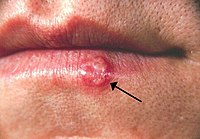
Photo from wikipedia
Herpes simplex virus (HSV) infection, the most prevalent viral infection that typically lasts for a lifetime, is associated with frequent outbreaks of oral and genital lesions. Oral herpes infection is… Click to show full abstract
Herpes simplex virus (HSV) infection, the most prevalent viral infection that typically lasts for a lifetime, is associated with frequent outbreaks of oral and genital lesions. Oral herpes infection is mainly associated with HSV-1 through oral contact, while genital herpes originates due to HSV-2 and is categorized under sexually transmitted diseases. Immunocompromised patients and children are more prone to HSV infection. Over the years, various attempts have been made to find potential targets for the prevention of HSV infection. Despite the global distress caused by HSV infections, there are no licensed prophylactic and therapeutic vaccines available on the market against HSV. Nevertheless, there are numerous promising candidates in the pre-clinical and clinical stages of study. The present review gives an overview of two herpes viruses, their history, and life cycle, and different treatments adopted presently against HSV infections and their associated limitations. Majorly, the review covers the recent investigations being carried out globally regarding various vaccine strategies against oral and genital herpes virus infections, together with the recent and advanced nanotechnological approaches for vaccine development. Consequently, it gives an insight to researchers as well as people from the health sector about the challenges and upcoming solutions associated with treatment and vaccine development against HSV infections.
Journal Title: Vaccines
Year Published: 2023
Link to full text (if available)
Share on Social Media: Sign Up to like & get
recommendations!